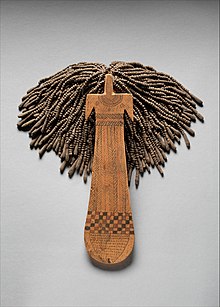Paddle doll

Paddle dolls are a type of ancient Egyptian female figurine that have been excavated from various tombs. Paddle dolls have been found in burials from the late Sixth Dynasty to the Thirteenth Dynasty from tombs in Asasif, Beni Hassan, Naga el-Deir, Rifeh, Sheikh Farag and Thebes.[1][2] The period of their greatest popularity seems to have been the late Eleventh and early Twelfth Dynasties.[3]
Form
Paddle dolls are made of thin pieces of wood which depict the torso of a woman with truncated arms and no legs. Thick “hair” is represented by small beads strung along string, which are often made from black mud.
Function

- The location of where paddle dolls have been excavated serves as evidence to this claim. A large majority of paddle dolls have been found in Theban burials.[2] The khener-troupe of performers were from Thebes, which is where the cult of Hathor was located.
- The same tattoos found on the body of the Priestess of Hathor and Sole Royal Ornament Amunet and the female bodies found in the same burial courtyard have been found on paddle dolls.[2] The exact type of diamond-shaped configurations found on the body were discovered in the same regions (shoulders, thighs, and/or buttocks) of various paddle dolls excavated from multiple tombs.[2]
- There are parallels between the outfits worn by the khener women and those depicted on paddle dolls. A thin beaded top that was known to be worn by the khener-troupe dancers has been witnessed on some paddle dolls. The most commonly found example is a checkerboard pattern that covers the public region.[2]
- Paddle dolls were commonly excavated near clappers, one of the most typical instruments used by khener-troupes in order to keep a rhythm. Additionally, the figurines were often discovered in groups that mirrored the composition of real troupes of musicians and dancers.[2]
Previous Claims
Many early theorizations regarding paddle dolls' uses have lost support as they relied on assumptions and interpretations, while the more recent studies linking paddle dolls to the Theban khener-troupe are supported by multiple lines of evidence and research. One discarded hypothesis identified the artifacts as fertility symbols placed in burials to guarantee eternal rebirth.[7] The hypothesis stated the paddle dolls’ emphasis on feminine attributes such as the breast, hips, and pubic area symbolized the sexual aspects of regeneration.[8] This hypothesis was formed solely on the shape of the artifact and had no research to support the claim.
Another claim argued that paddle dolls were intended for similar purposes as the menat necklaces. Priestesses of Hathor honored the goddess Hathor by shaking menat necklaces, which were made of a long, flat plate with a bulb at the bottom and many strands of stringed beads at the top.[2] Early theorizations suggested paddle dolls were intended for noise-making or used as toys; however, it is probable that the paddle dolls would not have been able to withstand vigors shaking.[2] This allows Egyptologists to rule out the idea that they were meant to be shaken to produce a sound.
References
- ^ a b c d Hernández, Roberto A. Díaz (January 2017). ""Paddle Dolls" - Ritual Figurines of Fertility". Company of Images: Modelling the Imaginary World of Middle Kingdom Egypt (2000-1500 BC): Proceedings of the International Conference of the EPOCHS Project Held 18th-20th September 2014 at UCL, London: 125–132.
- ^ JSTOR 24555386.
- ^ Bourriau, Janine; Quirke, Stephen (1988). "Pharaohs and Mortals: Egyptian Art in the Middle Kingdom". Cambridge University Press.
- ^ "Paddle Doll". www.metmuseum.org. Retrieved 2020-11-19.
- ^ Griffin, Ken (2019-04-22). "Egypt Centre Collection Blog: The Tattooed Lady of the Egypt Centre". Egypt Centre Collection Blog. Retrieved 2021-03-19.
- ^ Morris, E. (2017). Middle Kingdom clappers, dancers, birth magic, and the reinvention of ritual. In G. Miniaci, M. C. Betrò, & S. Quirke (Eds.), Company of images: Modelling the imaginary world of Middle Kingdom Egypt (2000-1500 BC): Proceedings of the international conference of the EPOCHS project held 18th-20th September 2014 at UCL, London (pp. 285–336). Peeters.
- JSTOR 604800.
- ^ "paddle doll | British Museum". The British Museum. Retrieved 2020-12-07.
Further reading
- Graves-Brown, C. Dancing for Hathor: Women in Ancient Egypt. Bloomsbury Academic, 2010.
- Pinch, G. Egyptian Mythology: A Guide to the Gods, Goddesses, and Traditions of Ancient Egypt. Oxford University Press, 2004.
- Capel, A.K. and G.E.Markoe, eds.. Mistress of the House Mistress of Heaven. Women in Ancient Egypt. New York : Hudson Hills Press, 1997.
- Hart, G. Ancient Egypt-2 (London, Dorling Kindersley in association with the British Museum, 1990.
- Bourriau, J. Egyptians and Mortals. Egyptian Art in the Middle Kingdom. Cambridge University Press, 1988.
